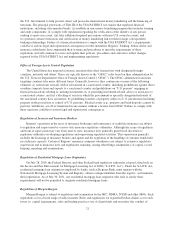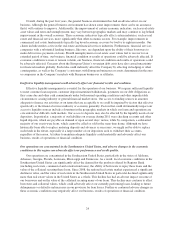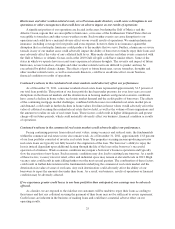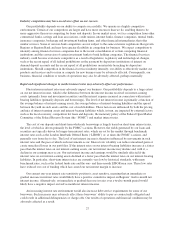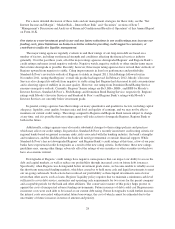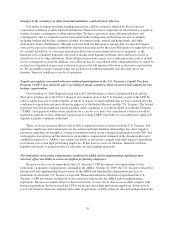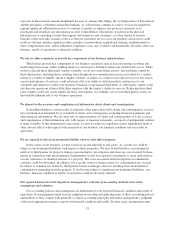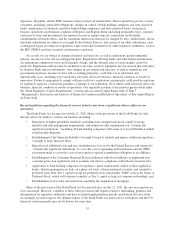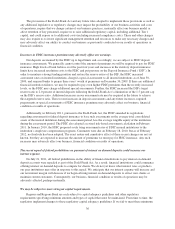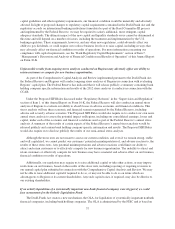Regions Bank 2011 Annual Report Download - page 51
Download and view the complete annual report
Please find page 51 of the 2011 Regions Bank annual report below. You can navigate through the pages in the report by either clicking on the pages listed below, or by using the keyword search tool below to find specific information within the annual report.Industry competition may have an adverse effect on our success.
Our profitability depends on our ability to compete successfully. We operate in a highly competitive
environment. Certain of our competitors are larger and have more resources than we do, enabling them to be
more aggressive than us in competing for loans and deposits. In our market areas, we face competition from other
commercial banks, savings and loan associations, credit unions, internet banks, finance companies, mutual funds,
insurance companies, brokerage and investment banking firms, and other financial intermediaries that offer
similar services. Some of our non-bank competitors are not subject to the same extensive regulations that govern
Regions or Regions Bank and may have greater flexibility in competing for business. We expect competition to
intensify among financial services companies due to the recent consolidation of certain competing financial
institutions and the conversion of certain investment banks to bank holding companies. The financial services
industry could become even more competitive as a result of legislative, regulatory and technological changes,
such as the recent repeal of all federal prohibitions on the payment by depository institutions of interest on
demand deposit accounts and the recent repeal of all prohibitions on interstate branching by depository
institutions. Should competition in the financial services industry intensify, our ability to effectively market our
products and services and to retain or compete for new business may be adversely affected. Consequently, our
business, financial condition or results of operations may also be adversely affected, perhaps materially.
Rapid and significant changes in market interest rates may adversely affect our performance.
Fluctuations in interest rates may adversely impact our business. Our profitability depends to a large extent
on our net interest income, which is the difference between the interest income received on interest-earning
assets (primarily loans and investment securities) and the interest expense incurred in connection with interest-
bearing liabilities (primarily deposits and borrowings). The level of net interest income is primarily a function of
the average balance of interest-earning assets, the average balance of interest-bearing liabilities and the spread
between the yield on such assets and the cost of such liabilities. These factors are influenced by both the pricing
and mix of interest-earning assets and interest-bearing liabilities which, in turn, are impacted by external factors
such as the local economy, competition for loans and deposits, the monetary policy of the Federal Open Market
Committee of the Federal Reserve System (the “FOMC”) and market interest rates.
The cost of our deposits and short-term wholesale borrowings is largely based on short-term interest rates,
the level of which is driven primarily by the FOMC’s actions. However, the yields generated by our loans and
securities are typically driven by longer-term interest rates, which are set by the market through benchmark
interest rates such as the London Interbank Offered Rates (“LIBOR”) or, at times the FOMC’s actions, and
generally vary from day to day. The level of net interest income is therefore influenced by movements in such
interest rates and the pace at which such movements occur. Interest rate volatility can reduce unrealized gains or
create unrealized losses in our portfolios. If the interest rates on our interest-bearing liabilities increase at a faster
pace than the interest rates on our interest-earning assets, our net interest income may decline and, with it, a
decline in our earnings may occur. Our net interest income and earnings would be similarly affected if the
interest rates on our interest-earning assets declined at a faster pace than the interest rates on our interest-bearing
liabilities. In particular, short-term interest rates are currently very low by historical standards, with many
benchmark rates, such as the federal funds rate and the one- and three-month LIBOR near zero. These low rates
have reduced our cost of funding which has caused our net interest margin to increase.
Our current one-year interest rate sensitivity position is asset sensitive, meaning that an immediate or
gradual increase in interest rates would likely have a positive cumulative impact on Regions’ twelve-month net
interest income. Alternatively, an immediate or gradual decrease in rates over a twelve-month period would
likely have a negative impact on twelve-month net interest income.
An increasing interest rate environment would also increase debt service requirements for some of our
borrowers. Such increases may adversely affect those borrowers’ ability to pay as contractually obligated and
could result in additional delinquencies or charge-offs. Our results of operations and financial condition may be
adversely affected as a result.
27






